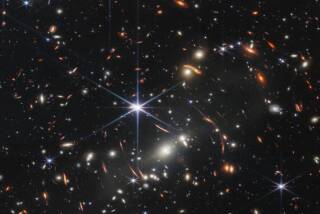ASTRONOMY
NASA’s Hubble Space Telescope has captured the best image ever of an unusual galaxy known as Hoag’s Object, discovered by astronomer Art Hoag in 1950. A nearly perfect ring of hot, blue stars pinwheels about the galaxy’s yellow nucleus. The galaxy is about 120,000 light-years wide, slightly larger than our Milky Way Galaxy, and is 600 million light-years away in the constellation Serpens.
The blue ring, which is dominated by clusters of young, massive stars, contrasts sharply with the yellow nucleus of mostly older stars. The apparent gap separating the ring from the nucleus may, in fact, be filled with star clusters that are too faint to see.
Astronomers speculate that the blue ring may be the shredded remains of another galaxy that passed nearby about 2 to 3 billion years ago.
Further details are available at: oposite.stsci.edu/pubinfo/pr/2002/21.





